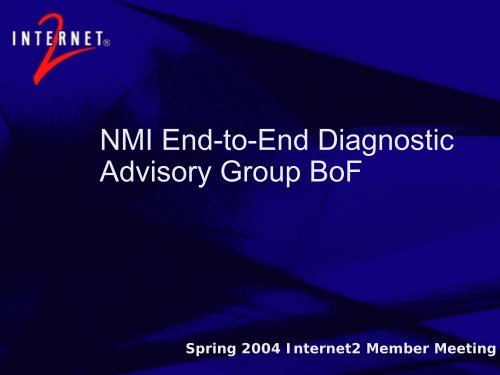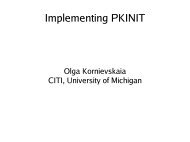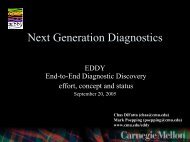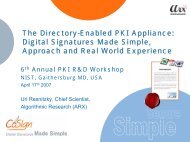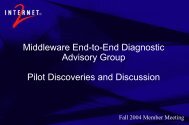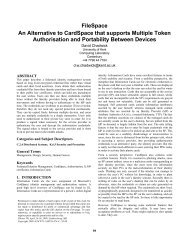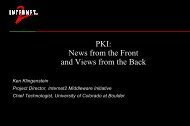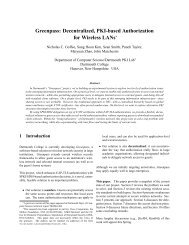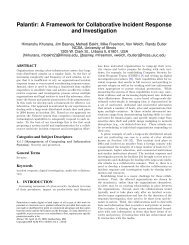NMI-EDIT End-To-End Diagnostic Advisory Group BOF (PDF)
NMI-EDIT End-To-End Diagnostic Advisory Group BOF (PDF)
NMI-EDIT End-To-End Diagnostic Advisory Group BOF (PDF)
Create successful ePaper yourself
Turn your PDF publications into a flip-book with our unique Google optimized e-Paper software.
<strong>NMI</strong> <strong>End</strong>-to-<strong>End</strong> <strong>Diagnostic</strong><br />
<strong>Advisory</strong> <strong>Group</strong> BoF<br />
Spring 2004 Internet2 Member Meeting
•Progress Report<br />
Outline<br />
• Review of goals<br />
• Problem analysis from the perspective of the user<br />
• Survey<br />
• Architecture<br />
• Event data<br />
• Dissemination<br />
•Present Efforts<br />
•Timeline<br />
•Conclusion<br />
14 April 2004 2
Review of Year One Goals<br />
Engage <strong>NMI</strong>-<strong>EDIT</strong> and GRIDS efforts<br />
Gather feature requirements from the perspective of the<br />
user, origin and target/application operators<br />
Be conscious of privacy feature requirements with<br />
respect to architecture, but defer implementation until<br />
year two<br />
Survey and report on market, research activities, and<br />
standards efforts in this space<br />
• Initially focus on simple solutions to quickly aid in the<br />
analysis and evolution of middleware diagnostic support<br />
• Create a modular architecture to prepare for a rich<br />
toolset in year two<br />
14 April 2004 3
•Progress Report<br />
Outline<br />
• Review of goals<br />
• Problem analysis from the perspective of the user<br />
• Survey<br />
• Architecture<br />
• Event data<br />
• Dissemination<br />
•Present Efforts<br />
•Timeline<br />
•Conclusion<br />
14 April 2004 4
Requirements Gathering<br />
•Identify diagnosticians in specific areas<br />
• Administrators, operators, engineers and developers<br />
• Widening effort to include the Security and Network<br />
Performance diagnosticians<br />
•Capture requirements by writing detailed<br />
scenarios<br />
• Day in the life before/after<br />
• <strong>To</strong>p 10 questions that they need to solve<br />
• Participants - Shibboleth, MACE-DIR, GRiDS, P2P<br />
(Lionshare), E2EP, IM<br />
14 April 2004 5
Scenario Process Findings<br />
• No access to the diagnostic data<br />
• Correlating different diagnostic data types<br />
• Application, network, system and security<br />
• Discovering valuable information in a sea of<br />
data<br />
• Providing evidence to prove or repudiate a<br />
diagnosis<br />
• Finding time to create tools to transfer<br />
knowledge to help less skilled organizations<br />
and/or individuals diagnose problems<br />
14 April 2004 6
•Progress Report<br />
Outline<br />
• Review of goals<br />
• Problem analysis from the perspective of the user<br />
• Survey<br />
• Architecture<br />
• Event data<br />
• Dissemination<br />
•Present Efforts<br />
•Timeline<br />
•Conclusion<br />
14 April 2004 7
Survey of <strong>Diagnostic</strong> <strong>To</strong>ols<br />
•Broken down into three areas<br />
• Highly focused based on solving a specific problem<br />
• Log file analysis and management<br />
• Broad scope, combining data from many different<br />
sources to form a comprehensive solution<br />
•Lots of tools<br />
•Effort far from complete<br />
•Living document<br />
14 April 2004 8
Survey Findings<br />
• Highly specialized<br />
• Deep – TCP performance, LDAP tuning, etc.<br />
• Broad – Albilene load, Web statistics, etc.<br />
• Beginning to see signs of comprehensive tools (MOM)<br />
• Most focused vertically only using network,<br />
host, or application diagnostic data types<br />
• Measurement based vs. event, active vs.<br />
passive<br />
• Difficult to correlate events and anomalies<br />
between tools<br />
• Limited to one type of input data format. I.e.<br />
they can’t take advantage of other rich sources<br />
of diagnostic data<br />
14 April 2004 9
•Passive<br />
• Log files<br />
• Network flow data<br />
•Active<br />
<strong>Diagnostic</strong> Methods<br />
• Injecting transactions<br />
• Correlating with passive techniques<br />
•Performance Measurement<br />
• Specific instrumentation tests<br />
• Summarization from multiple elements<br />
• Can map into the event domain<br />
14 April 2004 10
•Progress Report<br />
Outline<br />
• Review of goals<br />
• Problem analysis from the perspective of the user<br />
• Survey<br />
• Architecture<br />
• Event data<br />
• Dissemination<br />
•Present Efforts<br />
•Timeline<br />
•Conclusion<br />
14 April 2004 11
What if…<br />
•The collection and management of a wide<br />
variety of event data was made simple<br />
•All application, host and network events<br />
could be correlated with each other<br />
•There existed an API where developers<br />
could rapidly build new tools that use this<br />
rich set of data and its management<br />
infrastructure<br />
14 April 2004 12
Architecture Goals<br />
• Expose a wide array of diagnostic data to<br />
diagnostic tool developers<br />
• Make it simple to add new data types<br />
• Construct a scalable, secure and reliable<br />
collection and dissemination facility<br />
• Provide methods to manipulate, search, and<br />
retrieve the data<br />
• Create an simple API to use the methods<br />
• Deploy the methods on popular development<br />
platforms<br />
14 April 2004 13
Steps to Enable <strong>Diagnostic</strong><br />
Applications<br />
• Establish the common event record<br />
• Enable the collection of events from a<br />
wide array of event sources<br />
• Network: NetFlow, SNMP, RMON, etc<br />
• Security: IDS, Snort, firewalls, etc<br />
• Applications: Shib, Dir, IM, P2P, smtpd, named,<br />
httpd, Kerberos, etc<br />
• Hosts: /var/log/*, Syslog, etc<br />
14 April 2004 14
Steps to Enable <strong>Diagnostic</strong><br />
Applications (2)<br />
• Build tools to create dissemination<br />
infrastructures that,<br />
• Allows access to the diagnostic data<br />
• Provides operators to filter, anonymize, aggregate,<br />
tag, store and archive the data<br />
• Enables pipelining of data operators to organize<br />
and manipulate diagnostic data based on an<br />
organization or federations policies<br />
• Provide a common API so applications can access<br />
the diagnostic data<br />
14 April 2004 15
What types of input events?<br />
• Application and Host<br />
• Syslog<br />
• /var/log/*<br />
• http-access/error<br />
• MS specific (security, application and event logs)<br />
• Application specific (AFS, SHIB, LDAP, SMTP, etc.)<br />
• “many others”<br />
•Network<br />
•NetFlow<br />
•SNMP<br />
•RMON<br />
• Others?<br />
•Security<br />
•IDS<br />
• Cisco CNS<br />
• Snort<br />
• Others?<br />
14 April 2004 16
Enabling <strong>Diagnostic</strong> Applications<br />
With a Common Event Descriptor<br />
<strong>Diagnostic</strong> applications (Middleware, Network, Security) can extract<br />
event data from multiple data sets<br />
Dissemination Network<br />
Collection and Normalization of Events<br />
Middleware<br />
Related Events<br />
Network<br />
Related Events<br />
Security<br />
Related Events<br />
14 April 2004 17
Enabling <strong>Diagnostic</strong> Applications<br />
With a Common Event Descriptor<br />
<strong>Diagnostic</strong> applications (Middleware, Network, Security can extract<br />
event data from multiple data sets<br />
Meas:”OWAMP-I2”<br />
OWAMP:start test<br />
Normal:”core”<br />
netflow:flow rec<br />
Error:”primary dns”<br />
DNS:can’t recurse<br />
Meas:”core-q”<br />
SNORT:unknown ser<br />
Critical:”Aston App”<br />
SHIB:shire not found<br />
Critical:”Firewall-A”<br />
IDS:excessive flows<br />
Middleware<br />
Related Events<br />
Network<br />
Related Events<br />
Security<br />
Related Events<br />
14 April 2004 18
Event Record<br />
Event Descriptor Meta Field<br />
Event Descriptor<br />
Raw Event Data<br />
• Version Number<br />
• Observation Description Pointer<br />
• ID – unique event identifier<br />
• Time - start/stop<br />
• IP Address(es) – source/(destination)<br />
• Source Class – application, network, system, compound, bulk, management<br />
• Event Name Tag – Native language ID, user defined<br />
• Status – normal, informational, warning, measurement, critical, error, etc.<br />
• Major Source Name – filename, Netflow, Syslogd, SNMP, shell program, etc.<br />
• Minor Source Name – logging process name (named), SNMP variable name, etc.<br />
• Raw Data Encoding Mechanism – Binary, ASN1, ASCII, XML, etc.<br />
• Raw Event Data Description Pointer<br />
14 April 2004 19
Event Record<br />
Event Descriptor Meta Field<br />
Event Descriptor<br />
Raw Event Data<br />
• Observation Description Pointer<br />
• Address type of observer (IPV4, IPV6, MAC, etc.)<br />
• Address of observer<br />
• Address type of collection agent (IPV4, IPV6, MAC, etc.)<br />
• Address of collection agent<br />
• Source Type (file, stream, polled, interrupt)<br />
• Collection agent name (Netflow.1.0, named.2.3, etc.)<br />
14 April 2004 20
Event Record<br />
Event Descriptor Meta Field<br />
Event Descriptor<br />
Raw Event Data<br />
• Raw Event Data Description Pointer<br />
• Schema of raw event data<br />
• Parser code<br />
14 April 2004 21
Event Record<br />
Event Descriptor Meta Field<br />
Event Descriptor<br />
Raw Event Data<br />
• Event Name Tag – (null), user defined (can be multiple tags)<br />
• Examples:<br />
• “astronomy-app”<br />
• “ShibUserHandle=foo”<br />
• “WebFront<strong>End</strong>”<br />
14 April 2004 22
Event Record Overhead<br />
Event Descriptor Meta-Field<br />
Event Descriptor<br />
Raw Event Data<br />
• Version Number – 1 byte<br />
• Observation Description Pointer –4 bytes<br />
• ID – 10 bytes<br />
• Time – 24 or 12 bytes<br />
• IP Address(es) – (8 or 16 bytes) * 2 for IPV6<br />
• Source Class –1 byte<br />
• Event Name Tag – 0 to 16 bytes typical (can be as large as 256)<br />
• Status –1 byte<br />
• Major Source Name – 0 to 32 bytes typical (can be as large as 256)<br />
• Minor Source Name – 0 to 16 bytes typical (can be as large as 256)<br />
• Raw Data Encoding Language -1 byte<br />
• Raw Event Data Description Pointer – 4 Bytes<br />
14 April 2004 23
Simple Implementation<br />
Consolidation of Web Events<br />
Web server Web server Web server<br />
<strong>Diagnostic</strong><br />
Host<br />
• HTTP-access<br />
• HTTP-error<br />
• /var/log/messages<br />
• /var/log/cron<br />
• Syslog<br />
Collection Module<br />
Processing Module<br />
14 April 2004 24
Simple Implementation<br />
Enterprise Web Enabled Application<br />
Router<br />
AuthN Server Web Server Target App<br />
Collection Module<br />
<strong>Diagnostic</strong><br />
Host<br />
Processing Module<br />
• HTTP-access<br />
• HTTP-error<br />
• /var/log/messages<br />
• /var/log/cron<br />
• Syslog<br />
• App logs<br />
• Shib logs<br />
14 April 2004 25
Advanced Implementation<br />
Enterprise Event Collection<br />
Router<br />
7500 Router<br />
7200 Router<br />
Collection 6509 Router Host<br />
Web 6509 Server Router<br />
Collection Host<br />
NetFlow Events<br />
Collection Module<br />
<strong>Diagnostic</strong><br />
Host<br />
6509 Switch<br />
<strong>Diagnostic</strong> Apps<br />
Processing Module<br />
<strong>Diagnostic</strong><br />
Host<br />
<strong>Diagnostic</strong><br />
Host<br />
• HTTP-access<br />
• HTTP-error<br />
• /var/log/messages<br />
• /var/log/cron<br />
• Syslog<br />
• App logs<br />
• Shib logs<br />
• NetFlow<br />
14 April 2004 26
Complex Implementation<br />
Alerting apps, filtering<br />
data to federation<br />
and API to NMS<br />
Federation specific<br />
reporting, performance<br />
and forensic apps<br />
Collection Modules<br />
Massive collection,<br />
normalization,<br />
filtering or tagging<br />
Enterprise<br />
Processing Modules<br />
Archive, querying<br />
Reporting,<br />
performance, and<br />
forensic apps<br />
Federation<br />
14 April 2004 27
Internal Operators<br />
Data Management/Access<br />
Internal Monitoring<br />
Housekeeping<br />
AuthN/<br />
AuthZ<br />
Control and<br />
Configuration<br />
Data Repository<br />
Archive<br />
DB<br />
D<br />
D<br />
D<br />
D<br />
D<br />
Record Manipulation<br />
Filter Aggregator Anonymizer<br />
Tagging<br />
14 April 2004 28
Host or<br />
Security<br />
Events<br />
<strong>Diagnostic</strong> Data Pipelining<br />
Data flows can be constructed to provide the desired<br />
function and policy within an enterprise or federation<br />
C-1<br />
C-2<br />
C-3<br />
P-1<br />
P-2 P-4<br />
Network<br />
Events<br />
C-4<br />
P-3 P-5<br />
Filter<br />
Tagging<br />
Normalization<br />
Aggregation<br />
Anonimization<br />
DB<br />
Archive<br />
C-* Collection Module Host<br />
P-* Processing Module Host<br />
14 April 2004 29
Backplane Elements<br />
Network, System, &<br />
Application Events<br />
<strong>Diagnostic</strong> Apps<br />
API<br />
Collection Agent<br />
Query<br />
CPI<br />
Storage<br />
Manipulation<br />
Manipulation<br />
Access<br />
Control<br />
Secure and Reliable Transport<br />
Collection Module<br />
Processing Module<br />
14 April 2004 30
•Progress Report<br />
Outline<br />
• Review of goals<br />
• Problem analysis from the perspective of the user<br />
• Survey<br />
• Architecture<br />
• Event data<br />
• Dissemination<br />
•Present Efforts<br />
•Timeline<br />
•Conclusion<br />
14 April 2004 31
Present Efforts<br />
• Joint effort between security, E2EP and<br />
E2ED<br />
• Do we share common problems building<br />
diagnostic tools the their supporting<br />
infrastructures?<br />
• Can we benefit from each others diagnostic efforts<br />
and the data collected?<br />
• Will a common event record to enable correlation?<br />
• Can we share an event collection and decimation<br />
infrastructure that enables the evolution of<br />
diagnostic applications?<br />
14 April 2004 32
• Participants<br />
Present Efforts (2)<br />
• Eric Boyd (I2)<br />
• Chas DiFatta (CMU)<br />
• Ken Kingenstein (I2)<br />
• Russ Hobby (I2)<br />
• Cheryl Munn-Fremon (I2)<br />
• Mark Poepping (CMU)<br />
• Marty Schulman (I2)<br />
• Matt Zekauskas (I2)<br />
14 April 2004 33
Pilot Objectives<br />
• Study the normalization strategies of the diagnostic data<br />
• Build an ultra modular architecture where the impact of<br />
its evolution is minimized<br />
• Collect and distribute the data in a highly flexible<br />
manner via piping of diagnostic data streams<br />
• Leverage resources of other initiatives where possible<br />
to achieve a common goal<br />
• Provide simple operators to manipulate data<br />
• Enable basic forensic applications<br />
14 April 2004 34
Pilot Feature Roadmap<br />
• Collection Module<br />
• CPI Version 1<br />
• Management layer – summary reporting only<br />
• Event record format version 1<br />
• 5+ agents (1 sample)<br />
• Local configuration<br />
• Processing Module<br />
• API Version 1<br />
• Simple querying and filtering of stored records<br />
• Can connect to real-time stream<br />
• Authentication TBD<br />
• No ‘traditional db’, records stored in files<br />
• Event record operators – filter(regex), T, Y and tag<br />
• 3 <strong>To</strong>ols - forensic, reporting, and sample<br />
• Local configuration with pipelining<br />
14 April 2004 35
•Progress Report<br />
Outline<br />
• Review of goals<br />
• Problem analysis from the perspective of the user<br />
• Survey<br />
• Architecture<br />
• Event data<br />
• Dissemination<br />
•Present Efforts<br />
•Timeline<br />
•Conclusion<br />
14 April 2004 36
Year One Activity Timeline<br />
Month<br />
Activities Status Sep – Nov 03 Dec – Feb<br />
04<br />
Mar – May 04<br />
Jun – Aug<br />
04<br />
Sep<br />
04<br />
Pre-Startup<br />
Done<br />
Startup<br />
Done<br />
<strong>End</strong>-user Requirement<br />
Definition and Survey<br />
Done<br />
Architecture and Design<br />
Active<br />
Development, Testing and<br />
Distribution<br />
Postmortem<br />
Major Milestones<br />
• <strong>Advisory</strong> <strong>Group</strong> Formed<br />
• <strong>BOF</strong> at I2 Oct 03<br />
• User Requirements Finalized<br />
• Architecture/Design Finalized<br />
• Internal Release<br />
• Beta Release<br />
• Pilot Release<br />
14 April 2004 37
Conclusion<br />
•Seeing a common need for a<br />
diagnostic framework spanning<br />
E2EP, security and middleware<br />
•Looking for participants in the Pilot<br />
•Developers (collection agents, applications)<br />
•Testers<br />
•For more information,<br />
•http://middleware.internet2.edu/e2ed<br />
•Or contact chas@cmu.edu<br />
14 April 2004 38
•Progress Report<br />
Outline<br />
• Review of goals<br />
• Problem analysis from the perspective of the user<br />
• Survey<br />
• Architecture<br />
• Event data<br />
• Dissemination<br />
•Present Efforts<br />
•Timeline<br />
•Conclusion<br />
14 April 2004 39


